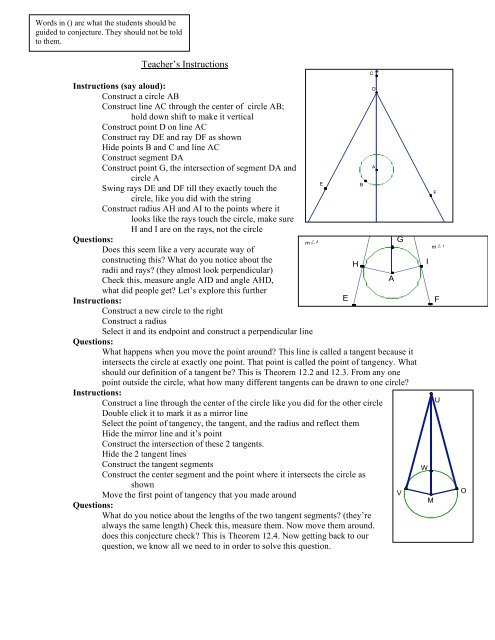The Geometry of a Circle - By: Dennis Kapatos
The Geometry of a Circle - By: Dennis Kapatos
The Geometry of a Circle - By: Dennis Kapatos
You also want an ePaper? Increase the reach of your titles
YUMPU automatically turns print PDFs into web optimized ePapers that Google loves.
Words in () are what the students should be<br />
guided to conjecture. <strong>The</strong>y should not be told<br />
to them.<br />
Teacher’s Instructions<br />
Instructions (say aloud):<br />
Construct a circle AB<br />
Construct line AC through the center <strong>of</strong> circle AB;<br />
hold down shift to make it vertical<br />
Construct point D on line AC<br />
Construct ray DE and ray DF as shown<br />
Hide points B and C and line AC<br />
Construct segment DA<br />
Construct point G, the intersection <strong>of</strong> segment DA and<br />
circle A<br />
Swing rays DE and DF till they exactly touch the<br />
circle, like you did with the string<br />
Construct radius AH and AI to the points where it<br />
looks like the rays touch the circle, make sure<br />
H and I are on the rays, not the circle<br />
Questions:<br />
Does this seem like a very accurate way <strong>of</strong><br />
constructing this? What do you notice about the<br />
radii and rays? (they almost look perpendicular)<br />
Check this, measure angle AID and angle AHD,<br />
what did people get? Let’s explore this further<br />
Instructions:<br />
Construct a new circle to the right<br />
Construct a radius<br />
Select it and its endpoint and construct a perpendicular line<br />
Questions:<br />
What happens when you move the point around? This line is called a tangent because it<br />
intersects the circle at exactly one point. That point is called the point <strong>of</strong> tangency. What<br />
should our definition <strong>of</strong> a tangent be? This is <strong>The</strong>orem 12.2 and 12.3. From any one<br />
point outside the circle, what how many different tangents can be drawn to one circle?<br />
Instructions:<br />
Construct a line through the center <strong>of</strong> the circle like you did for the other circle<br />
Double click it to mark it as a mirror line<br />
Select the point <strong>of</strong> tangency, the tangent, and the radius and reflect them<br />
Hide the mirror line and it’s point<br />
Construct the intersection <strong>of</strong> these 2 tangents.<br />
Hide the 2 tangent lines<br />
Construct the tangent segments<br />
Construct the center segment and the point where it intersects the circle as<br />
shown<br />
Move the first point <strong>of</strong> tangency that you made around<br />
Questions:<br />
What do you notice about the lengths <strong>of</strong> the two tangent segments? (they’re<br />
always the same length) Check this, measure them. Now move them around.<br />
does this conjecture check? This is <strong>The</strong>orem 12.4. Now getting back to our<br />
question, we know all we need to in order to solve this question.<br />
E<br />
B<br />
C<br />
D<br />
A<br />
m ! A H D = 92.06 ° G<br />
m ! A ID = 93.00 °<br />
E<br />
H<br />
D<br />
A<br />
V<br />
I<br />
W<br />
M<br />
F<br />
F<br />
U<br />
O

















